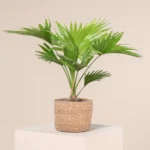Unveiling the Secrets of ZZ Plant Mastery: Cultivation, Care, and Commercial Success
Introduction
The ZZ Plant, scientifically known as Zamioculcas zamiifolia, has emerged as a superstar in the realm of indoor gardening due to its striking appearance and incredible resilience. Often celebrated as the ultimate low-maintenance plant, the ZZ Plant originates from the arid regions of Eastern Africa. It has adapted to endure long periods without water, making it perfectly suited for modern indoor environments where consistent care cannot always be guaranteed.
This guide delves deep into the art and science of cultivating the ZZ Plant, covering everything from basic care to advanced propagation techniques. Additionally, it explores the lucrative business opportunities that this hardy plant presents, making it a valuable addition not only to homes and offices but also to green businesses looking to expand their offerings.

Quick Facts
| Fact | Details |
|---|---|
| Scientific Name | Zamioculcas zamiifolia |
| Common Names | ZZ Plant, Zanzibar Gem, Aroid Palm |
| Year Discovered | Identified in the late 19th century |
| Kingdom | Plantae |
| Phylum | Angiosperms |
| Subphylum | Monocots |
| Class | Liliopsida |
| Order | Alismatales |
| Family | Araceae |
| Genus | Zamioculcas |
| Species | Z. zamiifolia |
| Native Region | Eastern Africa |
| Optimal Humidity | 40-50% |
| Optimal Temperature | 65-75°F (18-24°C) |
Physical Characteristics
The ZZ Plant is known for its waxy, lush green leaves that reflect sunlight, brightening rooms with less natural light. Its leaves grow on stems that can reach several feet in length, arching gracefully under the weight of the glossy foliage. This plant is not only a visual delight but also structurally robust, with a rhizomatous root system that effectively stores water to help it survive drought conditions.
Nutrition, Foods to Avoid
ZZ Plants require minimal feeding. To promote health and growth, a light application of a balanced, liquid fertilizer can be used at half strength during the growing season. It is essential to avoid over-fertilization, which can damage the plant’s root system and lead to leaf burn.

Health and Diseases
One of the remarkable traits of the ZZ Plant is its resistance to pests and diseases. However, it can occasionally suffer from root rot if overwatered. Ensuring that the plant is in well-draining soil and that excess water can escape the pot is crucial to prevent this issue.
Business: How to Make Money and Beyond
The ZZ Plant’s popularity among indoor plant enthusiasts, combined with its ease of care, makes it a profitable plant for nurseries and interior landscaping businesses. Its aesthetic appeal and air-purifying qualities make it a favored choice for office spaces, wellness centers, and homes, offering ample opportunities for entrepreneurs to market this plant effectively.
Pricing Information
| Type | Average Price |
|---|---|
| Small potted plant | $10 – $20 |
| Medium potted plant | $20 – $40 |
| Large potted plant | $40 – $60 |
Factors Affecting Price
- Plant Size: Larger plants are more valuable due to their visual impact and the time required to grow them.
- Pot Design: Plants sold in decorative pots can command higher prices.
- Local Market Trends: Prices may vary based on local demand and the popularity of indoor plants in the region.

Price in Different Regions
| Region | Average Price |
|---|---|
| USA | $30 |
| Europe | €25 |
| Asia | ₹2000 |
FAQs
| Question | Answer |
|---|---|
| How often should I water my ZZ Plant? | Water every 2-3 weeks, allowing the soil to dry completely between waterings. |
| What are the light requirements for a ZZ Plant? | ZZ Plants thrive in low to bright indirect light; avoid direct sunlight. |
| Is the ZZ Plant toxic to pets? | Yes, it is mildly toxic if ingested, so keep it out of reach of pets. |
Related Plants
Similar plants include the Aglaonema (Chinese Evergreen) and the Dracaena (Dragon Tree), both known for their low light tolerance and minimal watering needs.

References
Categories
Indoor Plants, Drought-Tolerant Plants, Low-Maintenance Plants, Air-Purifying Plants, Decorative Plants, Toxic Plants
This guide offers a wealth of information for anyone looking to integrate the ZZ Plant into their home or business. With its elegant appearance and remarkable resilience, the ZZ Plant continues to be a top choice for green enthusiasts and commercial growers alike.
Views: 3







